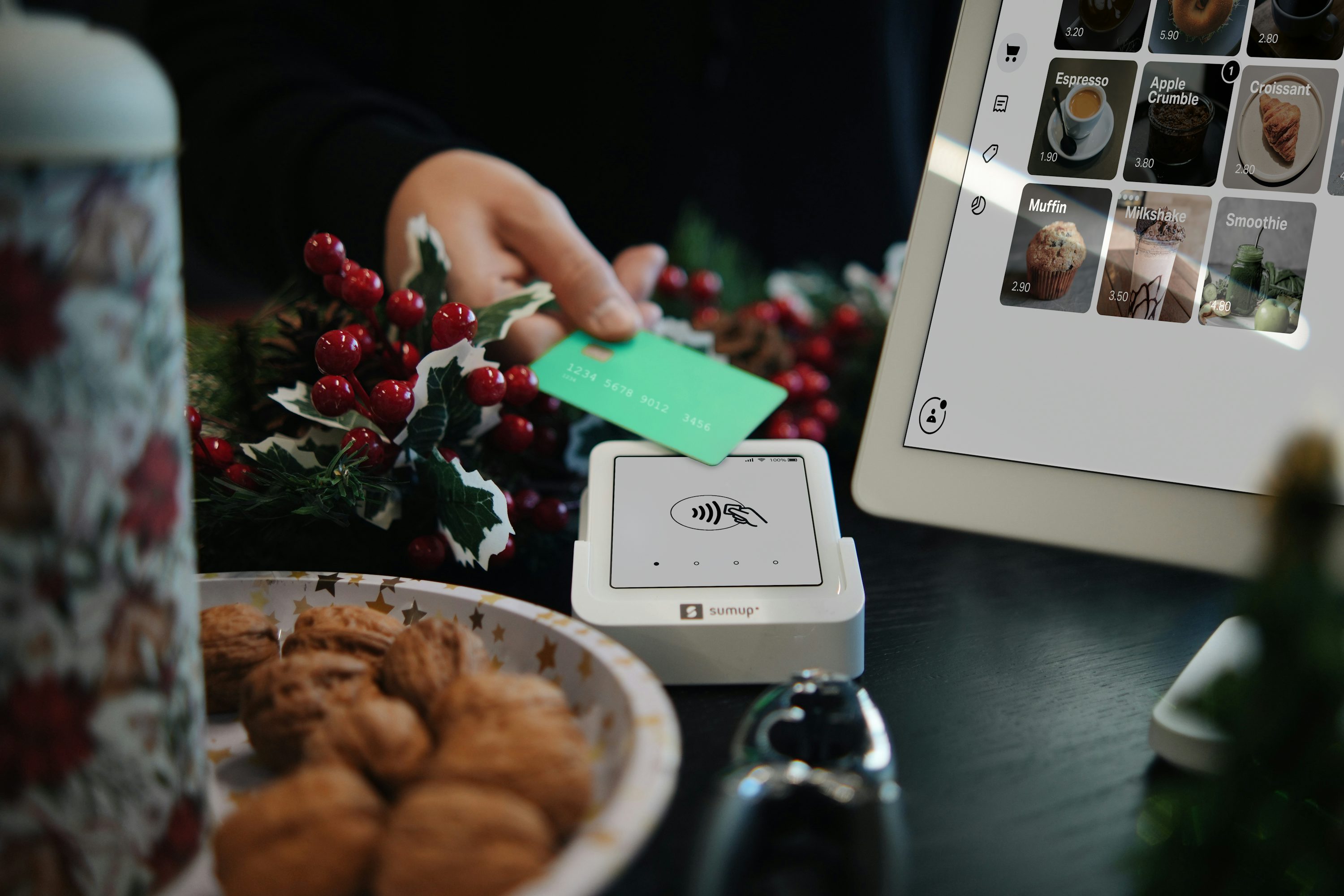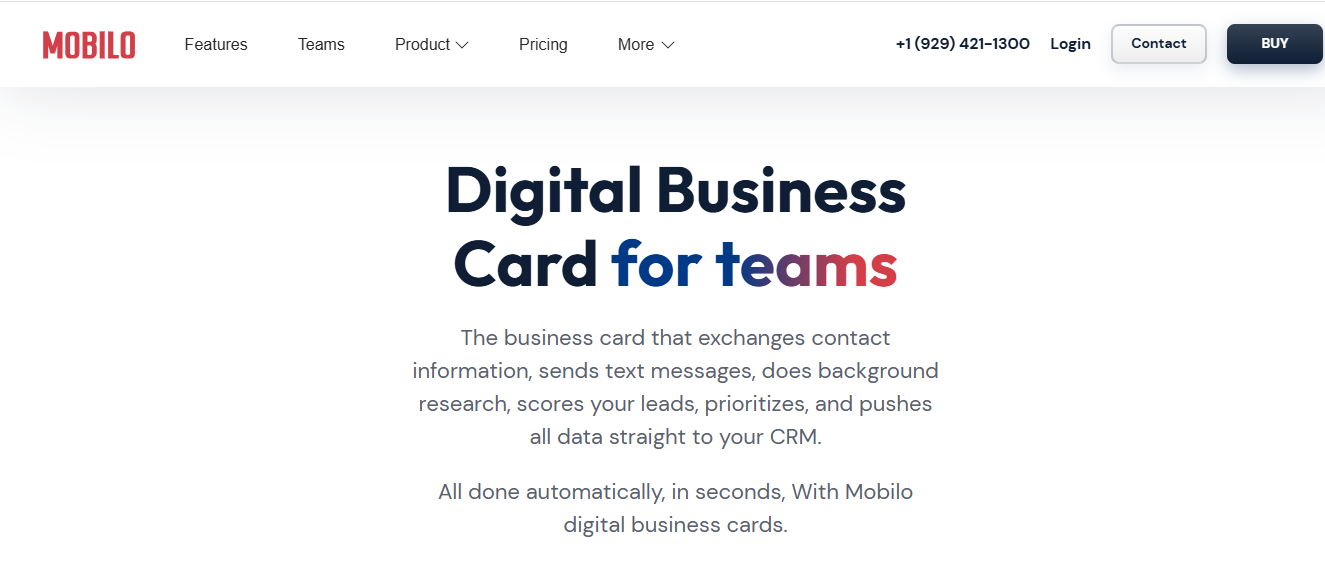.svg)

NFC technology now lets you share contact and product details with a single tap, pushing that data straight into your CRM. Digital sales transformation utilizes tools such as CRM integration, sales enablement, automation, analytics, and omnichannel engagement to refine your pipeline, expedite follow-up, and enhance conversion rates. This article will help you fully understand digital sales transformation and confidently implement the right tools and strategies to streamline your sales process, boost efficiency, and drive measurable revenue growth.
To make this practical, Mobilo's Digital Business Card turns NFC sharing into instant lead capture and simple analytics that you can use today; it syncs with your CRM, speeds up follow-up, and shows which conversations actually drive revenue.

Digital sales transformation involves the deliberate integration of digital tools, automation, and data into the sales process, enabling faster, more personalized, and measurable selling. It replaces one-off tactics with instrumented workflows that capture and act on signals, from event scans to CRM activity, so you convert encounters into a predictable pipeline.
Data and buyer expectations are the primary drivers. As buyers research and evaluate purchases online, sales no longer control the first half of the journey; buyers do. That pushes companies to shift from product-first habits to buyer-first systems that can listen, record, and respond at scale.
The subscription economy and readily available customer data accelerate this change because businesses that can deliver tailored, low-friction experiences capture more trials and retain more accounts.
Automation streamlines routine work, enabling reps to sell more, analytics reveal which accounts are most important, and integrated channels compress the sales cycle. According to Backlinko, digital sales transformation initiatives are expected to increase revenue by 20% over the next three years.
Companies planning for disciplined rollouts can expect material top-line gains. And when teams convert sales interactions into tracked, timely follow-ups, customers notice, which aligns with findings that Companies that have undergone digital sales transformation report a 30% increase in customer satisfaction. This is a clear indication that efficiency and experience reinforce each other.
If your go-to-market strategy still relies on paper trails and manual CRM entry, scaling will be hindered. Digital-first means meeting buyers where they already behave, automating repetitive handoffs, and instrumenting every touch so you can iterate.
Think of it as moving from static maps to live GPS. You still know the destination, but now you get real-time course corrections that save hours and lost opportunities.
Sales shift from manual administration to signal interpretation. Instead of copying contacts into spreadsheets and chasing cold email threads, reps use automated follow-up sequences, CRM integrations, and lead scoring to prioritize the 20 percent of interactions that drive most outcomes.
AI helps surface the best following action, and micro-optimizations like templated outreach and calendar nudges turn slow handoffs into one-click conversions. Think of it as swapping a wrench for a power tool. Same goal, much less wasted motion.
The raw inputs for selling are everywhere, including event taps, landing page visits, email opens, and social interactions. That flood of behavioral data necessitates a buyer-centric approach, enabling teams to map intent and tailor outreach. According to Backlinko, digital sales transformation initiatives are expected to increase revenue by 20% over the next three years.
Backlinko published a report in 2024, highlighting the top-line impact teams can expect when they instrument their sales end-to-end. When you stop guessing which prospects matter and start measuring who engages, the sales cadence becomes far more efficient.
Better measurement enhances both the customer experience and revenue. Customers get faster, more relevant responses because data routes the right offers to the right people at the right time, and service becomes proactive instead of reactive.
Backlinko reports that companies that have undergone digital sales transformation experience a 30% increase in customer satisfaction. Backlinko noted that in 2024, which shows transformation affects loyalty as much as pipeline. In practice, that means fewer frustrated buyers and more repeatable renewals.
Most teams still rely on paper cards, manual notes, or scattered spreadsheets because those methods are simple and low-friction at a small scale. That works until follow-up velocity matters and teams are trying to reconcile dozens of events, multiple reps, and complex account histories.
Information fragments, response time drifts to hours or days, and promising leads go cold before a human responds. This pattern consistently appears across conferences, enterprise meetings, and channel events, with the root cause always being the same. A lack of instrumented capture and automated routing.
Most teams hand off contacts with good intentions because physical cards feel human and familiar. As volume and expectations grow, that habit costs the pipeline. Leads are lost, follow-up is delayed, and teams lack visibility into who’s working on which accounts.
Teams find that platforms like Mobilo convert those passive exchanges into actionable data by pairing NFC, QR, and NameDrop cards with personalized landing pages, native CRM integrations, automated lead scoring, and follow-up workflows, giving sales operations a single source of truth while preserving the human moment at the exchange.
Data sharing between marketing and sales, event capture that pushes contacts directly into CRM, automated sequences that trigger based on behavior, and programmatic lead scoring are practical examples. Salespeople become more productive not because they work harder, but because systems capture context and act faster.
AI does two things for sales. It identifies patterns that humans miss, and it automates routine decisions, allowing reps to focus on high-value conversations. Predictive lead scoring, churn risk models, and sequence optimization are now feasible because models can ingest both historical outcomes and external signals.
The catch is data hygiene, because ML amplifies both signal and noise; if your CRM still contains stale or duplicated records, AI will magnify flawed conclusions. The correct sequence is clean data, small experiments, and then automated rollout.
Social channels are no longer optional for outreach; they are now essential for discovery and validation. Sales reps who share expertise, engage in relevant communities, and surface customer success build trust before a demo is requested. Social selling works best when it is supported by analytics that measure influence, lead attribution, and which content actually accelerates deals.
Digital service expands what “help” means, making support proactive and contextual rather than reactive and generic. That shift increases lifetime value because customers who get fast, channel-appropriate support stay longer and spend more.
Listening tools and integrated workflows enable teams to triage public issues and maintain consistent responses across channels quickly. When service and marketing share playbooks and a single view of the customer, fast public replies turn problems into brand wins instead of brand liabilities.
Self-service portals and intelligent knowledge bases reduce repetitive tickets, enabling customers to resolve common issues at their convenience. That saves agent hours while improving satisfaction, because many buyers prefer immediate answers over waiting on hold.
Chatbots handle routine queries and route complex issues to intelligent systems, allowing human agents to focus on higher-value work. Natural language understanding routes intent to the right specialist, and analytics on bot handoffs surface gaps in documentation or product UX that teams can fix.
Different industries adopt the same principles but apply them to distinct problems. In banking, open APIs and mobile-first experiences speed approval and reduce branch dependency.
In retail, digital receipts, contactless loyalty via NFC or QR codes, and inventory signals enable personalized upselling at checkout. In insurance, telematics and connected sensors let carriers price risk more accurately and engage customers with preventive insights rather than reactive claims processing.
A frequent error is treating technology like a bandage, adding point tools without redesigning the workflow. If you bolt in an analytics layer but keep manual handoffs, the signals never reach the rep in time.
Another pitfall is content that reads like an academic report instead of a buyer-focused story; it fails to move decision-makers because it lacks clear KPIs and before/after evidence. This pattern occurs when marketing and sales operate with separate playbooks; the solution is shared metrics and a straightforward pipeline map that ties event capture to next-step actions.
If you need to make quick improvements at events, focus on capturing and implementing one-click follow-ups. When you need enterprise-level consistency, prioritize CRM integration, role-based visibility, and audit trails to ensure data remains reliable as headcount and event volume grow.
The tradeoff is speed versus governance; choose the smaller scope that delivers measurable outcomes first, then expand with automation and AI-driven scoring once the data is flowing.

Digital sales transformation turns guesses into controlled experiments you can scale by tightening handoffs, prioritizing the right leads, and proving each change in dollars. That payoff is real, as shown by the Digital Sales Transformation Report, which indicates that 70% of companies that have undergone digital sales transformation report increased revenue.
Look for metrics that drift in ways that conceal the real cost. Customer acquisition costs are rising while lead quality is falling, lead-to-opportunity conversion rates are slipping, and time-to-first-contact is creeping from hours to days.
After a three-month diagnostic across several mid-market sales stacks, the pattern was clear. Fragmented systems swallowed buyer signals, and response time moved from same-day to multi-day, and with it, the predictable pipeline evaporated. That combination is exhausting for reps and lethal for close rates.
Start with three operational KPIs that map directly to dollars:
Convert changes in those KPIs into expected revenue by applying your average deal size and historical win rate to any lift in qualified meetings. For example, a 10 percent increase in qualified meeting volume, at a known win rate and deal size, yields an immediate modelable uplift to forecasted revenue, not a vague “better performance” claim.
Targeted experiments win faster than platform shopping sprees. Run these actions with clear success criteria:
Tools amplify disciplined processes, and the payoff shows up in both rep output and the pipeline. That explains why Companies investing in digital sales tools see a 30% increase in sales productivity, according to a Sales Productivity Study. When your stack removes low-value admin tasks and surfaces the next-best action, reps spend more time selling and less time playing traffic cop.
Treat the model as an operational rule, not a black box. Pick five high-signal features, label six months of outcomes, train a simple model you can explain, pick two thresholds for automation, and measure impact on meeting-book rate and win rate over six weeks.
The choice of features matters more than model complexity; a transparent model that salespeople trust will be used, while a fancy model that no one understands will gather dust.
Design each test with a hypothesis tied to revenue, a minimum sample size, and a rollout plan. Example test: hypothesis, “High-score leads contacted within one hour will book meetings at a 25 percent higher rate than those contacted within 24 hours.”
Metric, meeting-book rate, and pipeline-weighted revenue; duration, four weeks or until statistical significance. If the test is successful, incorporate it into routing rules and update forecasts using the measured lift. Run the following experiment on a different lever and compound gains.

Select tools that align directly with the outcomes you require, and conduct targeted pilots that demonstrate adoption and integration before scaling. I recommend evaluating vendors based on their CRM-native connectors, predictable data contracts, security posture, and minimal workflow changes. Then, measure the impact with short, timeboxed experiments that are easy to roll back.
Begin with a concise checklist that you can validate during a demo. Ask for native CRM integrations, API documentation with examples, webhook retry behavior, SSO and role-based access, data residency and encryption details, and a clear uptime SLA..
If a vendor cannot show a sandbox, end the conversation. Build a field-level mapping document during vetting to avoid discovering mismatched fields after go-live.
Run a 6 to 8-week pilot with a clear control group and two measurable outcomes. Percent of in-person contacts converted into CRM records, and follow-up completion rate within 48 hours.
Timebox training to a single 90- to 120-minute session plus contextual in-app tips, then compare the pilot cohort to the control on those metrics. If the pilot improves conversion and speeds follow-up, it is safe to scale; if not, iterate on routing, scoring thresholds, or messaging before wider rollout.
After working with multiple mid-market sales operations over a three-month onboarding program, the pattern became clear. Resistance to change and unclear value drove nonuse. Remove friction by simplifying the flow to a single action for reps.
Use champions to model behavior for four weeks, and make success visible with a daily dashboard that shows captured and routed leads. Replace lengthy manuals with concise, task-focused training and one-click actions, enabling learning to occur during work, not after it.
Do not over-customize early. Complex field transforms or bespoke middleware can create fragile scripts, leading to lengthy maintenance burdens. Instead, lock a minimal canonical schema, use sandboxed API tests, and require idempotent webhooks with retry logic.
Expect connector failures, and build a daily reconciliation job that flags missing syncs and auto-retries so issues become data you fix, not surprises you discover in forecasting meetings.
If you operate in regulated industries, demand SOC2 or equivalent evidence, contractually defined breach notification windows, and explicit data deletion processes.
Choose vendors that support encryption at rest and in transit, provide audit logs, and allow role-based export controls. When you cannot accept cloud-hosted PII in certain regions, prefer vendors with regional data residency or on-prem options.
Translate pilot gains into a simple financial model, such as incremental leads captured, expected meetings from those leads, average deal size, and incremental close rate, offset by one-time purchase and recurring fees.
Also track operational metrics, such as sync success rate, average time from tap to CRM record creation, and rep time saved per lead, and gate expansion on sustained improvements over two consecutive months.

If you want to turn every handshake into a measurable pipeline and generate 10x more leads at events, join over 59,000 companies that've switched to intelligent digital business cards that automatically exchange contact details, enrich lead data, score prospects against your ICP, and sync directly to your CRM.
Book a demo today and receive your first 25 Cards Free, valued at $950. We both know that paper cards get tossed, and too many contacts, often 90 percent, never make it into your CRM.